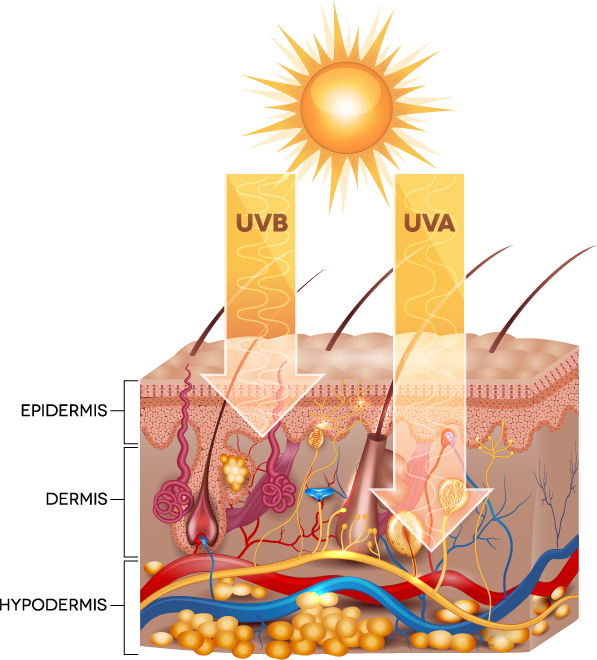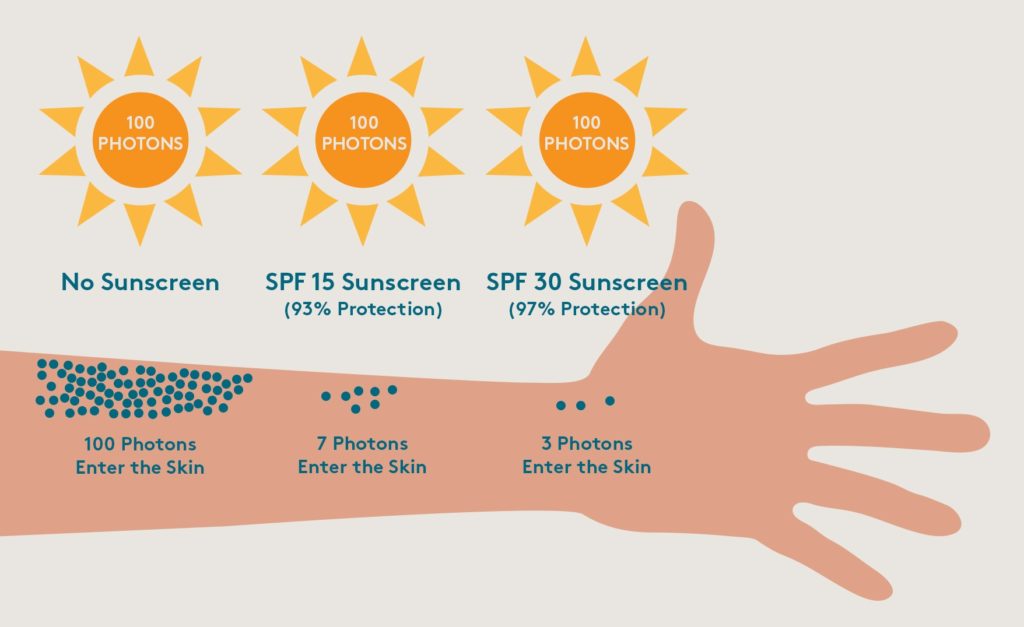Summer is finally here, and the sunshine promises to be generous this season! Before you run out to snag some rays, here’s some information on sunscreen and how to protect your skin throughout the year.
Why do we need sun protection?
As much as it feels amazing to soak up the sun’s warm rays, there comes a point where the sun can become damaging to your skin’s cellular matrix – the collection of molecules that form the foundation for your skin.
The sun emits different types of radiation, including infrared, visible, and ultraviolet (UV) light. UVA and UVB are 2 types of ultraviolet rays that can get soaked up by the skin. UVB is absorbed at the skin’s surface and leads to burning. UVA penetrates into the deeper layers, aging the skin and enhancing wrinkles. Both types have the potential to distort DNA, and overexposure leads to an increased risk of skin cancer.

This is why it is so important to assist the skin with sun-protecting accessories, clothing, and sunscreen.
What sunscreen options are out there?
There are two different types of sunscreens available: chemical and mineral. Chemical sunscreens do the work of absorbing the UV light so your skin doesn’t, whereas the mineral ingredients physically bounce the rays away from your skin. Both prevent the sun’s rays from entering the skin barrier.
While these are all effective at shielding the body from harmful rays, there is growing concern of the impact of chemical sunscreens on the environment and our endocrine system. The active ingredients from sunscreen are absorbed into the bloodstream and can exceed the FDA threshold of 0.5 nanograms per milliliter of blood after just one application. It is unclear at this time what effects these chemicals have on the body long-term.
Of the chemical sunscreens available, oxybenzone has gotten the most press due to its interference with marine life and is banned in many vacation destinations for the sake of environmental preservation. It may also be an endocrine disrupter for fish and humans, meaning it interferes with normal hormone production.
Mineral sunscreens, such as zinc oxide and titanium dioxide, are considered more environmentally friendly and healthier for humans. Although thicker in consistency, and with the possibility of leaving a white residue on the skin, they are less absorbed by the body and have not been shown to interfere with hormones.
How to interpret sunscreen ratings
SPF stands for Sun Protection Factor. This measures a range of time that the product should protect you from the sun before you burn. This particularly focuses on UVB protection.
There are 2 ways to analyze SPF:
- SPF as a multiplication of protection time: If it takes you 15 mins of sunshine to burn, wearing SPF 10 would, theoretically, prolong this by 10x = allowing you to stay out in the sunshine for 150 minutes without burning.
- The other way to look at it is based on the % of UVB rays an SPF is blocking. SPF 15 provides about 93% protection, while a SPF 50 protects by 98%. (4)

Resource: Colorescience
You may have also seen some sunscreens include a PA+ rating, which means “Protection Grade of UVA”. This system was developed in Japan to represent how much UVA protection the product offers. You can see a range from PA+ (some UVA protection) to PA++++ (extremely high UVA protection).
Luckily most sunscreen products in the US are Broad Spectrum, meaning they protect from both UVB and UVA rays.
Recommendations for safe sun exposure:
- Find out your city’s UV Index forecast for the day. The higher the #, the more intense the sun’s rays will be. If the forecast is 3 or above, sun protection is a good idea.
- Select a sunscreen that is:
- At least SPF 30+
- Broad-spectrum to block out both UVA/UVB rays
- Water Resistant to ensure the SPF protection is doing its job while you sweat or get wet
- Mineral sunscreens are a win for your body and the environment
- Use the Environmental Working Group’s guide to understand more about sunscreen ingredients.
- For maximum protection, sunscreen should be applied directly onto the skin, underneath makeup. While it’s great that some cosmetic products provide SPF, it is still important to layer on a sunscreen for adequate protection.
- Reapply every 2 hours while you’re out in the sun.
Have fun out there!
Dr. Grace Chang is a Naturopathic Doctor, acupuncturist, and avid sun chaser.
*All information provided on the Natural Medicine of Seattle blog is for informational purposes only and should not be considered medical advice. Please do not implement any treatment program without speaking with your doctor first.
References:
- “EWG Skin Deep®: What Is Oxybenzone.” EWG, www.ewg.org/skindeep/ingredients/704372-oxybenzone/.
- Reproductive Toxicology (Elmsford, N.Y.), U.S. National Library of Medicine, 4 July 2018, pubmed.ncbi.nlm.nih.gov/29981360/.
- Matta, Murali K. “Effect of Sunscreen Application on Plasma Concentration of Sunscreen Active Ingredients.” JAMA, American Medical Association, 21 Jan. 2020, jamanetwork.com/journals/jama/article-abstract/2759002.
- “Sunscreen.” The Skin Cancer Foundation, June 2019, www.skincancer.org/skin-cancer-prevention/sun-protection/sunscreen/.
- “What Does the PA+ Sunscreen Symbol Mean?: Paula’s Choice.” Paula’s Choice Skincare, www.paulaschoice.com/expert-advice/skincare-advice/sun-care/what-does-pa-sunscreen-symbol-mean.html.

